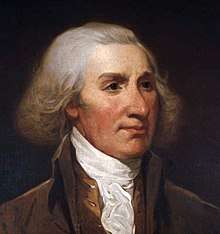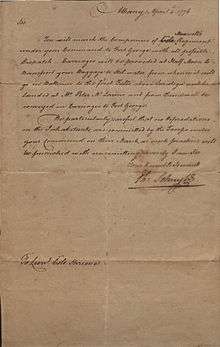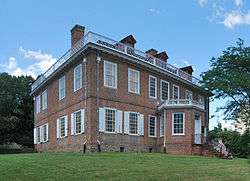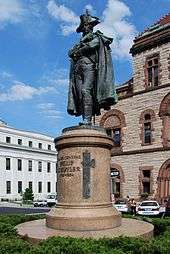Philip Schuyler
| Philip Schuyler | |
|---|---|
 | |
| United States Senator from New York | |
|
In office July 16, 1789 – March 3, 1791 | |
| Preceded by | position established |
| Succeeded by | Aaron Burr |
|
In office March 4, 1797 – January 3, 1798 | |
| Preceded by | Aaron Burr |
| Succeeded by | John Sloss Hobart |
| New York State Surveyor General | |
|
In office 1781–1784 | |
| Preceded by | position established |
| Succeeded by | Simeon De Witt |
| Personal details | |
| Born |
Philip John Schuyler November 20, 1733 Albany, Province of New York |
| Died |
November 18, 1804 (aged 70) Albany, New York, U.S. |
| Resting place | Albany Rural Cemetery[1] |
| Political party |
Pro-Administration, Federalist |
| Spouse(s) | Catherine Van Rensselaer |
| Children |
Angelica Schuyler Church Elizabeth Schuyler Hamilton Margarita "Peggy" Schuyler Van Rensselaer John Bradstreet Schuyler Philip Jeremiah Schuyler Rensselaer Schuyler Cornelia Schuyler Morton Catherine V. R. Schuyler |
| Parents |
Johannes Schuyler, Jr. Cornelia van Cortlandt |
| Relatives | See Schuyler family |
| Profession | Soldier, Statesman |
| Military service | |
| Service/branch |
|
| Rank | Major General |
| Battles/wars | |
Philip John Schuyler (/ˈskaɪlər/; November 20 [O.S. November 9] 1733 – November 18, 1804) was a general in the American Revolution and a United States Senator from New York.[2] He is usually known as Philip Schuyler, while his son is usually known as Philip J. Schuyler.
Born in Albany, Province of New York, into the prosperous Schuyler family, Schuyler fought in the French and Indian War. He won election to the New York General Assembly in 1768 and to the Continental Congress in 1775. He planned the Continental Army's 1775 Invasion of Quebec, but poor health forced him to delegate command of the disastrous invasion to Richard Montgomery. He prepared the Continental Army's defense of the 1777 Saratoga campaign, but was replaced by General Horatio Gates as the commander of Continental forces in the theater. Schuyler resigned from the Continental Army in 1779.
Schuyler served in the New York State Senate for most of the 1780s and supported the ratification of the United States Constitution. He represented New York in the 1st United States Congress but lost his state's 1791 Senate election to Aaron Burr. After a period in the state senate, he won election to the United States Senate again in 1797, affiliating with the Federalist Party. He resigned due to poor health the following year. He was the father of Elizabeth Schuyler Hamilton and the father-in-law of Secretary of the Treasury Alexander Hamilton.
Early life
Philip John Schuyler was born on November 20 [O.S. November 9] 1733[3] in Albany, New York, to Cornelia Van Cortlandt (1698–1762) and Johannes ("John") Schuyler Jr. (1697–1741), the third generation of the Dutch family in America.
Before his father died on the eve of his eighth birthday, Schuyler attended the public school at Albany. Afterward, he was educated by tutors at the Van Cortlandt family estate at New Rochelle. In 1748 he began to study with Reverend Peter Strouppe at the New Rochelle French Protestant Church, where he learned French and mathematics. While he was at New Rochelle he also joined numerous trade expeditions where he met Iroquois leaders and learned to speak Mohawk. He joined the British forces in 1755 during the French and Indian War, raised a company, and was commissioned as its Captain by his cousin, Lt. Governor James Delancey. Later in that war, he served as a quartermaster, purchasing supplies and organizing equipment.
Family
Philip was related to many illustrious contemporaries, including: Peter Schuyler, a cousin who commanded the Jersey Blues; Hester Schuyler, a cousin who married William Colfax, a veteran of George Washington's Life Guards and later a general in the New Jersey militia who also commanded the Jersey Blues (William and Hester were the grandparents of Vice President and Speaker of the House Schuyler Colfax); Arent Schuyler DePeyster (cousin), a noted Loyalist; Mary (Watts) Johnson, a second cousin who was a Loyalist and wife of Colonel Sir John Johnson; and Dr. John Cochran, a brother-in-law who was the Director General of the Military Hospitals of the Continental Army.[4] His daughter Elizabeth married Alexander Hamilton who was the first Secretary of the Treasury to the United States under George Washington.[5]
Career
Early career
From 1761 to 1762, Schuyler made a trip to England to settle accounts from his work as quartermaster. He began construction on his home in Albany, later called Schuyler Mansion, during this time. He also began construction of his country estate (now known as the General Schuyler House), at Saratoga.
In 1768, Schuyler began his political career as a member of the New York Assembly, serving in that body until 1775. During that time, his views came to be more opposed to the colonial government, particularly in matters of trade and currency. He was made a colonel in the militia for his support of Governor Henry Moore.
Revolutionary War

Schuyler was elected to the Continental Congress in 1775, and served until he was appointed a major general of the Continental Army in June. General Schuyler took command of the Northern Department, and planned the Invasion of Canada (1775). His poor health required him to place Richard Montgomery in command of the invasion.
As department commanding general, he was active in preparing a defense against the Saratoga Campaign, part of the "Three Pronged Attack" strategy of the British to cut the American Colonies in two by invading and occupying New York State in 1777. In the summer of that year General John Burgoyne marched his British army south from Quebec over the valleys of Lakes Champlain and George. On the way he invested the small Colonial garrison occupying Fort Ticonderoga at the nexus of the two lakes. When General St. Clair abandoned Fort Ticonderoga in July, the Congress replaced Schuyler with General Horatio Gates, who had accused Schuyler of dereliction of duty. In 1778, Schuyler and Arthur St. Clair were court-martialed for the loss of Ticonderoga, but were both acquitted.[6][7]
Battle of Saratoga
The British offensive was eventually stopped by Continental Army then under the command of Gates and Benedict Arnold in the Battle of Saratoga. That victory, the first wholesale defeat of a large British force, marked a turning point in the revolution, for it convinced France to enter the war on the American side. When Schuyler demanded a court martial to answer Gates' charges, he was vindicated but resigned from the Army on April 19, 1779. He then served in two more sessions of the Continental Congress in 1779 and 1780.
Schuyler was an original member of the New York Society of the Cincinnati.
Later career
After the war, he expanded his Saratoga estate to tens of thousands of acres, adding slaves, tenant farmers, a store, mills for flour, flax, and lumber. His flax mill for the making of linen was the first one in America. He built several schooners on the Hudson River, and named the first Saratoga.
He was a member of the New York State Senate from 1780 to 1784, and at the same time New York State Surveyor General from 1781 to 1784. Afterwards he returned to the State Senate from 1786 to 1790, where he actively supported the adoption of the United States Constitution.
In 1789, he was elected a U.S. Senator from New York to the First United States Congress, serving from July 27, 1789, to March 3, 1791. After losing his bid for re-election in 1791 to Aaron Burr, he returned to the State Senate from 1792 to 1797. In 1797, he was elected again to the U.S. Senate and served in the 5th United States Congress from March 4, 1797, until his resignation because of ill health on January 3, 1798.
Personal life
In September 1755, he married Catherine Van Rensselaer[8] (1734–1803) at Albany. She was the daughter of Johannes van Rensselaer (1707/08–1783) and his first wife, Engeltje Livingston (1698–1746/47). Johannes was the grandson of Hendrick van Rensselaer (1667–1740). Engeltje was the daughter of Robert Livingston the Younger. Philip and Catherine had 15 children together, eight of whom survived to adulthood, including:
- Angelica Schuyler (1756–1814), who married John Barker Church (1748–1818), later a British MP.
- Elizabeth Schuyler (1757–1854), who married Alexander Hamilton (1755/7–1804), later the first United States Secretary of the Treasury. Elizabeth co-founded the first private orphanage in New York City.[9]
- Margarita "Peggy" Schuyler (1758–1801), who married Stephen Van Rensselaer III (1764–1839), 8th Patroon.
- Cornelia (1761–1762).[10]
- Unbaptized Twin to Cornelia (1761–1761).[11]
- John Bradstreet Schuyler (1763–1764).[12]
- John Bradstreet Schuyler (1765–1795), who married Elizabeth Van Rensselaer (1768–1841), the sister of Stephen Van Rensselaer III who married his sister Peggy.[13]
- Philip Jeremiah Schuyler (1768–1835), who married first, Sarah Rutsen (d. 1805), and after her death, Mary Anna Sawyer. Philip served in the United States House of Representatives.
- Triplets (1770–1770, Unbaptized).[14]
- Rensselaer Schuyler (1773–1847), who married Elizabeth Ten Broeck, daughter of General Abraham Ten Broeck.[15]
- Cornelia Schuyler (1776–1808), who married Washington Morton.[16]
- Cortlandt Schuyler (1778–1778).[17]
- Catherine Van Rensselaer Schuyler (1781–1857), who married first, Samuel Malcolm (son of William Malcolm), and then James Cochran (1769–1848), her cousin and the son of John Cochran and Gertrude Schuyler, Philip Schuyler's sister.[18]
Schuyler's country home had been destroyed by General John Burgoyne's forces in September 1777. Later that year, he began rebuilding on the same site, now located in southern Schuylerville, New York. This later home is maintained by the National Park Service as part of the Saratoga National Historical Park, and is open to the public.
Schuyler died at the Schuyler Mansion in Albany on November 18, 1804, four months after his son-in-law, Alexander Hamilton, was killed in a duel. He is buried at Albany Rural Cemetery in Menands, New York.
 Schuyler Mansion, which was constructed from 1761 to 1765
Schuyler Mansion, which was constructed from 1761 to 1765
Legacy

To honor his legacy, many cities, structures, and statues have been named in his honor:
- Schuyler County, Illinois, Schuyler County, Missouri and Schuyler County, New York were named in his honor.
- The town of Schuyler, New York is named for him, as is the village of Schuylerville, New York.
- Fort Schuyler, constructed 1833-56, at the tip of Throggs Neck (a narrow spit of land in the southeastern portion of the borough of the Bronx in New York City) was named in his honor. The fort, built to defend the passage between the East River and Long Island Sound from sea invasion, now houses the Maritime Industry Museum and the State University of New York Maritime College.
- The Philip Schuyler Achievement Academy in Albany, New York is named in his and his son's honor.
- A statue of Schuyler, created by sculptor J. Massey Rhind in 1925 stands on the grounds of Albany's city hall.
- Schuyler was played by Sydney James Harcourt in the original cast of the Broadway musical Hamilton, a story about Schuyler's son-in-law, Alexander Hamilton.[19]
References
- Specific
- ↑ Column atop a large base. Sec. 29, lot 2, Albany Rural Cemetery, Menands, Albany, NY., Wilson, Scott. Resting Places: The Burial Sites of More Than 14,000 Famous Persons, 3d ed.: 2 (Kindle Location 42147). McFarland & Company, Inc., Publishers. Kindle Edition.
- ↑ NYSM: Philip Schuyler
- ↑ Gerlach, Don R. (1964). Philip Schuyler and the American Revolution in New York, 1733-1777. Lincoln, NE: University of Nebraska Press. p. 17.
- ↑ John Cochran Archived 2006-08-22 at the Wayback Machine. Office of Medical History
- ↑ http://www.biography.com/people/alexander-hamilton-9326481
- ↑ Lossing, Benson John (February 2009). The Life and Times of Philip Schuyler. Applewood Books. p. 320. ISBN 9781429016827. Retrieved February 26, 2018.
- ↑ "Major General Arthur St. Clair". National Museum of the United States Army. January 27, 2015.
- ↑ Catherine Van Rensselaer Find A Grave
- ↑ "Republican Court: Elizabeth Schuyler Hamilton (1757-1854)". www.librarycompany.org. Retrieved 2015-09-30.
- ↑ "Cornelia Schuyler (1761–1762)". FindAGrave. Retrieved 8 April 2016.
- ↑ Schuyler Family Bible, Collections of Schuyler Mansion State Historic Site, Albany, NY.
- ↑ "John Bradstreet Schuyler". FindAGrave. Retrieved 8 April 2016.
- ↑ Schuyler, George W. (1885). Colonial New York: Philip Schuyler and His Family, Volume 2. New York: Charles Scribner's Sons. p. 282.
- ↑ Schuyler Family Bible, Collections of Schuyler Mansion State Historic Site, Albany, NY.
- ↑ Bielinski, Stefan. "Rensselaer Schuyler". New York State Museum. Retrieved 22 April 2017.
- ↑ "This Day in History: Cornelia Schuyler and Washington Morton are married!". Facebook: Schuyler Mansion State Historic Site. October 7, 2015. Retrieved 8 April 2016.
- ↑ "Philip Schuyler". Ancestry.com. Retrieved 8 April 2016.
- ↑ Schuyler, George W. (1885). Colonial New York: Philip Schuyler and His Family, Volume 2. New York: Charles Scribner's Sons. p. 283.
- ↑ "Sydney James Harcourt | Playbill". Playbill. Retrieved 2017-01-12.
- General
- Barbagallo, Tricia (March 10, 2007). "Fellow Citizens Read a Horrid Tale" (PDF). New York Archives. Archived from the original (PDF) on May 19, 2009. Retrieved 2008-06-04.
- Revolutionary Enigma: A Re-Appraisal of General Philip Schuyler of New York by Martin H. Bush; 1969; ( ISBN 0-87198-080-0).
- Life of General Philip Schuyler, 1733–1804 by Bayard Tuckerman; 1903; (1969 reprint ISBN 0-8369-5031-3).
- Proud Patriot: Philip Schuyler and the War of Independence, 1775–1783 by Don Gerlach; 1987; Syracuse University Press; ( ISBN 0-8156-2373-9).
- The New York Civil List compiled by Franklin Benjamin Hough (pages 37f; Weed, Parsons and Co., 1858)
- The Real George Washington by the National Center for Constitutional Studies; 1991; 2009 reprint ISBN 0-88080-014-3
External links
- United States Congress. "Philip Schuyler (id: S000154)". Biographical Directory of the United States Congress.
- Co-Planner of the Sullivan-Clinton Campaign Against the Iroquois
- Collection of Letters from Philip Schuyler
- Philip Schuyler Achievement Academy
- Finding Aid to Schuyler Family Collection, 1679–1823 at the New York State Library
| Political offices | ||
|---|---|---|
| Preceded by new office |
New York State Surveyor General 1781–1784 |
Succeeded by Simeon De Witt |
| U.S. Senate | ||
| Preceded by None |
U.S. Senator (Class 1) from New York 1789–1791 Served alongside: Rufus King |
Succeeded by Aaron Burr |
| Preceded by Aaron Burr |
U.S. Senator (Class 1) from New York 1797–1798 Served alongside: John Laurance |
Succeeded by John Sloss Hobart |
